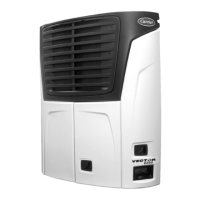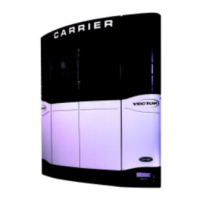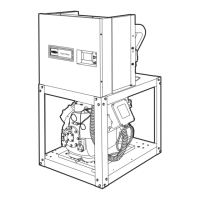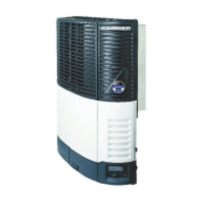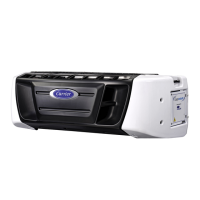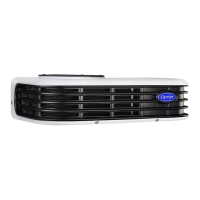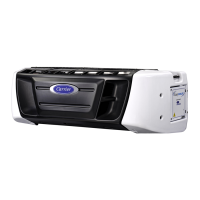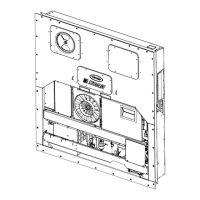62-61753-21
k. Check for proper unit operation by running Pretrip
(Refer to Section 3.4).
Adding A Partial Charge
a. Start the unit in high speed Engine Operation (am-
bient between 18°C (24°F) and 30°C (86°F) with a
setpoint of 20°C (68°F) or lower.
b. When return air reaches 0°C (32°F), check the sight
glasses.
c. If the bottom ball is floating at the top of the sight
glass and the top ball is not floating, the charge is
correct.
d. Liquid charge through the suction service valve.
e. Check for proper unit operation by running Pretrip
(Refer to Section 3.4).
8.5.6 Checking For Noncondensibles
To check for noncondensibles, proceed as follows:
1. Stabilize system to equalize pressure between the
suction and discharge side of the system. The en-
gine needs to be off for several hours.
2. Measure temperature at any of the copper tubing in
the condenser.
3. Check pressure at the compressor discharge ser-
vice valve.
4. Determine saturation pressure as it corresponds to
the condenser temperature using the Temperature-
Pressure Chart, Table 8-7.
5. If gauge reading is 0.2 bar (3 psig) or higher than
the calculated P/T pressure in step 4, nonconden-
sibles are present.
6. Remove refrigerant using a refrigerant recovery
system. (Refer to Section 8.5.1)
7. Evacuate and dehydrate the system. (Refer to Sec-
tion 8.5.3)
8. Charge the unit. (Refer to Section 8.5.5)
8.6 REFRIGERANT SYSTEM COMPONENT SER-
VICE
8.6.1 Compressor
Before removal of the compressor, relieve
the internal pressure by very carefully
loosening the couplings to break the seal.
The scroll compressor achieves low suc-
tion pressure very quickly. Do not use the
compressor to evacuate the system below
0 psig. Never operate the compressor with
the suction or discharge service valves
closed (frontseated). Internal damage will
result from operating the compressor in a
deep vacuum.
1. Mounting Hardware
2. Compressor
3. Suction Connection
4. Economizer Connec-
tion
5. Lifting Lug
6. Discharge Tempera-
ture Sensor
7. Discharge Connection
8. Power Plug
9. Oil Level Adjustment
Port
Figure 8-11. Compressor Kit
a. Remove the refrigerant charge. Refer to section
8.5.1
b. Ensure the unit is disconnected from the power
source and that SROS is in OFF position.
c. Frontseat the discharge and suction service valves
to help protect the remainder of the system.
d. Remove the Rotalock fittings from the suction and
discharge service connections, and uncouple the
economizer line from the compressor.
e. Disconnect the compressor discharge temperature
sensor (CDT) connector. The replacement com-
pressor comes with the compressor discharge tem-
perature sensor already assembled.
f. Remove and save the compressor base-mounting
bolts and washers.
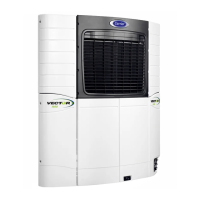
